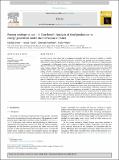Putting rooftops to use – A Cost-Benefit Analysis of food production vs. energy generation under Mediterranean climates
Author(s)
Benis, Khadija; Turan, Irmak; Reinhart, Christoph; Ferrão, Paulo
DownloadAccepted version (639.8Kb)
Terms of use
Metadata
Show full item recordAbstract
© 2018 Elsevier Ltd In today's growing cities, where land is an expensive commodity and direct exposure to sunlight is a valuable asset, rooftops constitute vast underexploited areas. Particularly with growing urban environmental concerns, the potential of transforming these areas into productive spaces – either for food cultivation or energy generation – has emerged as a viable option in recent years. Both food production and energy generation have benefits in the urban environment. Rooftop farming is an environmentally and economically sustainable way of exploiting urban rooftops, reducing “food miles” and providing local jobs, while roof-integrated solar photovoltaic (PV) modules provide clean energy, are increasingly cost-effective, and offer job opportunities. In both cases, a rooftop network of production could directly supply a portion of a necessary resource – either food or electricity – to the local community while concurrently reducing the burden on the environment. To provide a basis for comparing the implementation of these productive uses of rooftops in Mediterranean cities, this article applies a Cost-Benefit Analysis (CBA) to a mixed-use neighborhood located in Lisbon to assess the following uses: (1) open-air rooftop farming on intensive green roofs; (2) food production in low-tech unconditioned Rooftop Greenhouse (RG) farms; (3) Controlled-Environment Agriculture (CEA) in high-tech RG farms; and (4) solar PV energy generation. Relative costs, cost-saving benefits and added value of these four alternative productive uses of rooftops were modeled over 50 years and deducted from present value, considering two levels of analysis: (a) effects directly incurred by the operator of the systems; and (b) societal effects on the local community. To the authors’ knowledge, this is the first comprehensive comparison of rooftop PV versus rooftop farming technologies. The results have shown food production to be more beneficial than energy generation, for both the owner of the system and the local community, under the modeled conditions and given the selected items of comparison. In particular, the results show that rooftop greenhouse farming can provide significant benefits over rooftop green roof and solar PV systems when assessed from a holistic perspective that accounts for impacts on both the operator and the local community.
Date issued
2018-08Department
Massachusetts Institute of Technology. Department of ArchitectureJournal
Cities
Publisher
Elsevier BV
Citation
Benis, Khadija, Turan, Irmak, Reinhart, Christoph and Ferrão, Paulo. 2018. "Putting rooftops to use – A Cost-Benefit Analysis of food production vs. energy generation under Mediterranean climates." Cities, 78.
Version: Author's final manuscript
ISSN
0264-2751